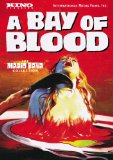| Reviews & Columns |
|
Reviews DVD TV on DVD Blu-ray 4K UHD International DVDs In Theaters Reviews by Studio Video Games Features Collector Series DVDs Easter Egg Database Interviews DVD Talk Radio Feature Articles Columns Anime Talk DVD Savant Horror DVDs The M.O.D. Squad Art House HD Talk Silent DVD
|
DVD Talk Forum |
|
|
| Resources |
|
DVD Price Search Customer Service #'s RCE Info Links |
|
Columns
|
|
|
Bay of Blood: Kino Classics Remastered Edition, A
Whack-fest. Kino Classics, under their Mario Bava Collection line, has released A Bay of Blood, the 1971 splatter giallo that you may also know as Twitch of the Death Nerve (its best, and best-known, title)...or Blood Bath...or Carnage...or Chain Reaction...or The Ecology of Crime...or Last House on the Left -- Part II...or New House on the Left...or any other number of titles it's gone under since its innumerable drive-in, grindhouse, VHS, and DVD releases. Starring Claudine Auger, Luigi Pistilli, Claudio Camaso, Anna Maria Rosati, Chris Avram, Leopoldo Trieste, Laura Betti, Brigitte Skay, Paola Montenero, Guido Boccaccini, Roberto Bonanni, and Isa Miranda, A Bay of Blood outraged and even disgusted many critics when it was first released (to less-than-impressive b.o.), but it has since gained quite the cult following, being rightfully acknowledged as the direct inspiration for the rip-off Friday the 13th franchise...which of course was instrumental here in America in starting our own "golden age" of splatter films in the 1980s. Seen today, A Bay of Blood is still top-tier splatter: clean, efficient butchery. A solid commentary track by Bava expert Tim Lucas is a nice extra for this clean HD widescreen transfer.
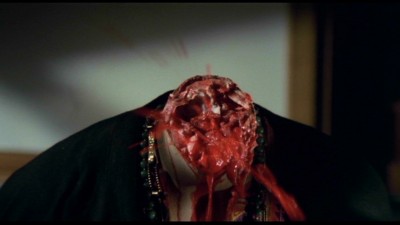
Countess Federica Donati (Isa Miranda), wheelchair-bound and alone at her villa on the bay, mournfully takes her last look out her rain-streaked window, before she is savagely strangled by a hanging rope. Her murderer, husband Count Filippo Donati (Giovanni Nuvoletti), impassively views his handiwork, leaving behind a bogus suicide note, before he is unexpectedly set-upon by a knife-wielding killer. Who, then, is his killer? There are many suspects at hand, right on the bay. Neighbor Frank Ventura (Chris Avram), a real estate developer, is interested in transforming the bay into a resort; did he kill the hold-out Countess? Or did his beautiful girlfriend, blonde Laura (Anna Maria Rosati), do it? What about sultry bitch Renata (Claudine Auger), the Countess' daughter, who's forced to live with her family in a squalid trailer on the estate? Maybe it was her weak-willed husband, Albert (Luigi Pistilli)? Maybe it was entomologist Paolo Fossati (Leopoldo Trieste), who lives nearby with his wife, psychic and tarot reader Anna (Laura Betti)? Or how about Simon (Claudio Camaso), the violent, anti-social half-son of the Countess, who lives in a shack on the estate? Did he kill the four sex-loving hippies (Brigitte Skay, Paola Montenero, Guido Boccaccini, Roberto Bonanni) who broke into Frank's abandoned bayside disco for a little fun and games? Who, indeed, will be left among these suspects, when one by one, they start getting bumped off, as well?
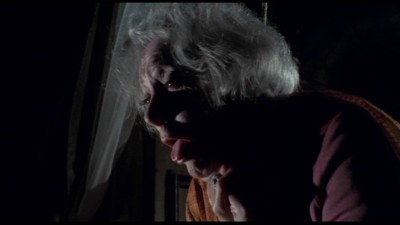
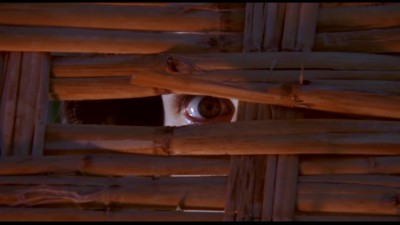
I doubt I can add too much to the reams that have been written about Bava's Twitch of the Death Nerve (that's the title I always associate with the movie, not this disc's A Bay of Blood). Hard-core splatter fans have already identified all the tropes Bava helped refine here in Twitch of the Death Nerve--visual, aural, and thematic motifs that have been imitated ad nauseum in subsequent horror/splatter outings. It's not a terribly difficult movie to dissect; as with many of Bava's movies, his themes are fairly accessible and he doesn't screw around when revealing them for us (when Bava would openly shoot for "art," such as in Lisa and the Devil, that's when he would get into trouble). That's his great strength: his powerful-yet-playful, relatively straightforward embrace of his own visual and aural conventions--conventions that are palpably, operatically visceral, leaving no mistake for the viewer about what he's trying to achieve with his horror and suspense efforts. You can intellectualize this particular movie if you want to, and you may be right in your theories...but on the same token, who doesn't understand the simple, primitive visual "poetry," if you will--the ironic, sick, perverted poetry, of course--of one of Bava's flamboyantly grotesque "kills"?
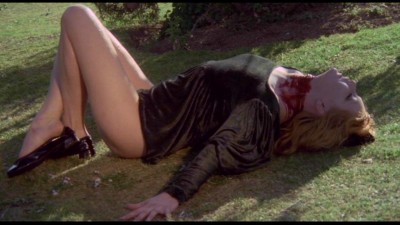
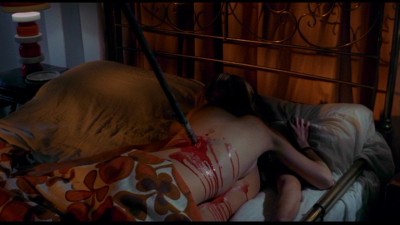
What works so well, so differently for Twitch of the Death Nerve, is Bava's insistence on stripping everything down to the absolute essentials of a murder mystery suspense thriller. There are no attempts to create fully dimensional characters, no attempt to create complex plotting, while mechanisms for suspense are pared back to their crudest, simplest expressions. Instead of elaborating on these elements as most suspense directors strive to do, Bava does the opposite here: paper-thin motivators with an almost clinical obsession put on depicting the actual killings. That isn't to say Bava doesn't have fun linking all these grotesqueries together (my favorite is when Rosati bares her breasts for Avram--a sight we unfortunately don't get to enjoy--right before Bava cuts to Camaso biting into what looks at first to be a repulsive, veiny breast...but which turns out to be an octopus). Setting up the first kill of the movie, he gives Italian movie legend Isa Miranda the Douglas Sirk treatment, with swirling, overripe music courtesy of Stelvio Cipriani, as she mournfully wheels around her opulent mausoleum of a mansion. Imagine, then, the shock Italian audiences in particular had when Bava then yanks the chair, literally, out from under them and hangs Miranda in a most horrifying manner; primed for Sirk, they're given sickness as Bava lingers over the strangulation, with Miranda's eyes bugged and tongue lolling, her guttural voice grunting and grasping. When Boccaccini and Rubens are harpooned during coitus, Bava cuts to a anthropomorphic dune buggy, complete with big Disney eyes and a smiling bumper. And when Betti gets her head chopped off, Bava cuts to Auger's kids breaking a ceramic head.
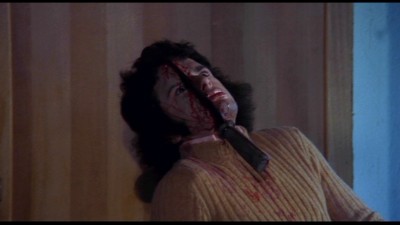
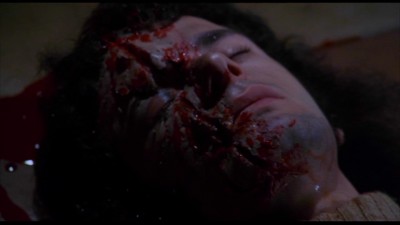
Quibbling about how Bava gets to his kills (I've read a few reviews that chide Bava's languid first act, as well as his leisurely montages) seems beside the point: the point of Twitch of the Death Nerve is the kills and nothing more. I rather like how the screenplay (credited to Bava, Giuseppe Zaccariello, Filippo Ottoni, and Sergio Canevari, from a story by Dardano Sacchetti and Franco Barberi) creates a ducks-in-a-shooting-gallery feel as each character is shown to be fairly loathsome in their venality--who cares if these creeps get it in the neck (you can take the four kids as either innocent victims caught in the crossfire of the bay's murderers...or callow hippies who deserve to die because they're interested in only their sexual appetites)? Unlike the imitators who came afterwards, particularly the ludicrous Friday the 13th series that introduced an increasingly silly supernatural element to the slice-and-dice, Bava's kills here are "human" at their most blankly base and terrifying (the money element here reminded me of William Castle's insistence on undercutting his villains' fake supernaturalism with good old-fashioned greed). I've never seen anything in one of those copycats (and I went to all of them...) that compares with the primitive, animal impact of the faceless killer prying that billhook out of still-blinking Bonanni's face, or with the simultaneously hilarious/deeply perverted death throes of nearly-decapitated Skay, who obligingly shoots the camera a sultry look while she assumes a calendar pin-up pose--she even crosses her ankles--before she expires. After Boccaccini and Rubens are speared during sex, Bava lets Rubens continue to grind Boccaccini until she perishes/climaxes...and then we get to sort out for ourselves how sick that is of us to notice. You don't see that kind of playful intelligence in too many of Bava's imitators. By the end of Twitch of the Death Nerve, MAJOR SPOILER ALERT! Bava yet again surprises us, reserving his best kill for last--"best" not because it's the most gruesome but because it's the most hilariously perverse: Auger and Pistilli's neglected children shotgun them down like something out of Looney Tunes, and then laugh at their silly game (their game...or the parents?). Did the kids do it by accident? Or have they inherited their parents' murderous disregard for human life? Who cares...it's the "kill" that counts here.
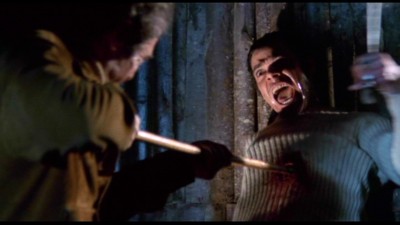
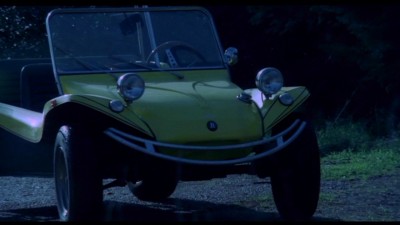
The DVD:
The Video:
According to the back of Kino's DVD hardcase, A Bay of Blood has been "mastered in HD from the 35mm negative of the English language version." Has that negative been cleaned up or restored? Can't say from the statement...but this anamorphically-enhanced, 1.78:1 widescreen looks far better than I've ever seen the title: colors are quite subtle, image sharpness is solid, contrast is decent, and no compression issues to speak of here. Very nice.
The Audio:
The split mono audio track is acceptable, with minimal hiss...and occasionally quite weird echo-chamber effect with some of the dialogue (is this original, or from the transfer?). No subtitles or closed-captions are available.
The Extras:
First, there's a good commentary track from Bava expert Tim Lucas, who gives plenty of background on the movie's production. Also very cool is an alternate European release version of A Bay of Blood, in Italian with English subtitles, that doesn't offer any new gore...but perhaps just a tiny bit more logical exposition. Not as nice looking, obviously, as the HD English version. Finally, an original trailer for A Bay of Blood, as well as other Bava films available through Kino.
Final Thoughts:
Pure and simple butchery...with a wink. If Bava didn't exactly invent modern splatter movies (Hitchcock and Psycho, don't you think?), he certainly definitively defined them, and probably the single most influential entry in the subgenre is 1971's A Bay of Blood. Stripped of all pretense, Bava skips any elaborate characterizations or suspense motivations, and gets down to work hacking apart and strangling and spearing his victims with single-minded, dirty-minded, perversely-mind good humor. I'm highly, highly recommending Kino's release of A Bay of Blood.
Paul Mavis is an internationally published movie and television historian, a member of the Online Film Critics Society, and the author of The Espionage Filmography.


|
| Popular Reviews |
| Sponsored Links |
|
|
| Sponsored Links |
|
|
| Release List | Reviews | Shop | Newsletter | Forum | DVD Giveaways | Blu-Ray | Advertise |
|
Copyright 2024 DVDTalk.com All Rights Reserved. Legal Info, Privacy Policy, Terms of Use,
Manage Preferences,
Your Privacy Choices | |||||||









